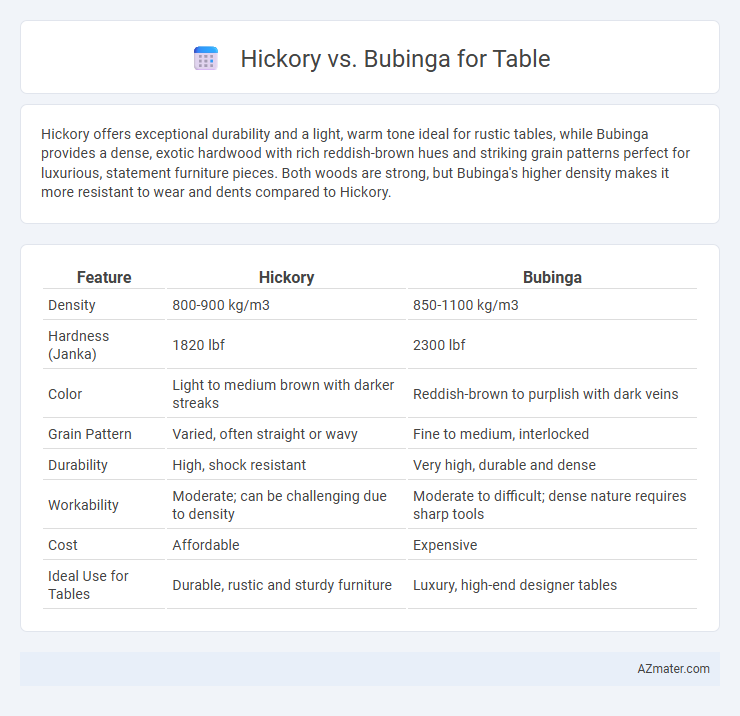Hickory offers exceptional durability and a light, warm tone ideal for rustic tables, while Bubinga provides a dense, exotic hardwood with rich reddish-brown hues and striking grain patterns perfect for luxurious, statement furniture pieces. Both woods are strong, but Bubinga's higher density makes it more resistant to wear and dents compared to Hickory.
Table of Comparison
| Feature | Hickory | Bubinga |
|---|---|---|
| Density | 800-900 kg/m3 | 850-1100 kg/m3 |
| Hardness (Janka) | 1820 lbf | 2300 lbf |
| Color | Light to medium brown with darker streaks | Reddish-brown to purplish with dark veins |
| Grain Pattern | Varied, often straight or wavy | Fine to medium, interlocked |
| Durability | High, shock resistant | Very high, durable and dense |
| Workability | Moderate; can be challenging due to density | Moderate to difficult; dense nature requires sharp tools |
| Cost | Affordable | Expensive |
| Ideal Use for Tables | Durable, rustic and sturdy furniture | Luxury, high-end designer tables |
Introduction to Hickory and Bubinga Wood
Hickory wood, prized for its exceptional hardness, shock resistance, and rich pale to medium brown tones with subtle reddish hues, provides durability ideal for heavy-use tables. Bubinga, a dense African hardwood, features vibrant reddish-brown and purple streaks with a smooth texture, offering a luxurious finish and excellent strength for fine furniture. Both woods present distinct aesthetic and functional qualities, making them popular choices for crafting sturdy, visually appealing tables.
Origin and Availability
Hickory, native to the eastern United States, is widely available due to its abundance in American forests, making it a popular choice for furniture like tables. Bubinga originates from Central and West Africa, where it grows in dense tropical forests, but its availability is more limited and often dependent on sustainable forestry practices. Due to these regional origins, hickory tables are generally easier to source and more cost-effective, while bubinga tables offer exotic appeal but may come with higher price points and sourcing restrictions.
Physical Appearance and Grain Patterns
Hickory features a light to medium brown color with prominent contrast between its heartwood and sapwood, displaying bold, wavy, and irregular grain patterns that add a rustic and dynamic appeal to tables. Bubinga exhibits a rich reddish-brown hue with occasional purplish tones, characterized by fine, interlocked, and often swirling grain patterns that create a luxurious and exotic look. The distinct grain complexity of Bubinga offers a more refined and polished aesthetic compared to Hickory's robust and textured appearance, making each wood ideal for different design preferences in table crafting.
Durability and Hardness Comparison
Bubinga wood exhibits superior hardness with a Janka rating around 2,540 lbf, making it significantly more durable and resistant to dents compared to Hickory, which has a Janka hardness of approximately 1,820 lbf. Hickory offers excellent shock resistance and toughness, making it ideal for tables subjected to heavy daily use, but Bubinga's dense fiber and natural oils enhance its longevity and resistance to wear. For long-lasting tables, Bubinga's hardness ensures better scratch and impact resistance, while Hickory remains a strong contender for durable furniture with a slightly softer feel.
Workability and Machining
Hickory offers excellent workability and machining properties due to its moderate hardness and fine grain, making it easier to cut, shape, and sand for table construction. Bubinga, with its higher density and interlocked grain, provides exceptional strength but requires sharper tools and more careful handling during machining to avoid tear-out. Both woods produce smooth finishes, but hickory is preferred for more intricate woodworking tasks, while bubinga's durability suits heavy-use tabletops.
Cost and Market Value
Hickory is a more cost-effective option for tables, offering durability and a warm aesthetic at a lower price point, typically ranging from $7 to $12 per board foot. Bubinga, prized for its rich color and exotic grain, commands a higher market value, often priced between $20 and $30 per board foot, making it a premium choice in luxury furniture. The market demand for Bubinga drives its value upward, while Hickory remains popular for budget-conscious buyers seeking strength and affordability.
Environmental Impact and Sustainability
Hickory is a hardwood known for its rapid growth and availability from sustainably managed forests, resulting in a lower environmental impact and better sustainability profile compared to slower-growing tropical species like Bubinga. Bubinga, often sourced from Central African rainforests, raises concerns regarding deforestation and habitat loss due to less regulated logging practices and longer growth cycles. Choosing Hickory for furniture, particularly tables, supports responsible forestry practices and reduces carbon footprint, making it a more eco-friendly option than Bubinga.
Maintenance and Care Requirements
Hickory tables demand regular sealing and occasional sanding to maintain their durability and resist moisture damage, making them suitable for households willing to invest time in upkeep. Bubinga offers a harder, denser wood surface that resists scratches and dents better, requiring less frequent refinishing but benefits from controlled humidity to prevent cracking. Both woods respond well to gentle cleaning with a soft cloth and mild soap, avoiding harsh chemicals that could degrade the finish or wood fibers over time.
Best Applications for Each Wood in Table Making
Hickory's exceptional strength and shock resistance make it ideal for heavy-use tables such as dining or work tables that demand durability and resilience. Bubinga's rich, deep reddish-brown color and fine grain pattern suit high-end, decorative tabletops where aesthetic appeal and luxury are prioritized. Hickory excels in rustic, farmhouse designs, while Bubinga is best applied in elegant, formal furniture requiring polished finishes and intricate detailing.
Final Verdict: Choosing Between Hickory and Bubinga
Hickory offers exceptional durability and a pronounced grain pattern, making it ideal for rustic and high-traffic tables, while Bubinga impresses with its rich, reddish-brown hue and smooth finish, perfect for elegant and sophisticated settings. For a table that demands both strength and a natural, textured aesthetic, hickory is a superior choice. When prioritizing a luxurious appearance combined with fine craftsmanship, bubinga stands out as the premium option.

Infographic: Hickory vs Bubinga for Table
 azmater.com
azmater.com